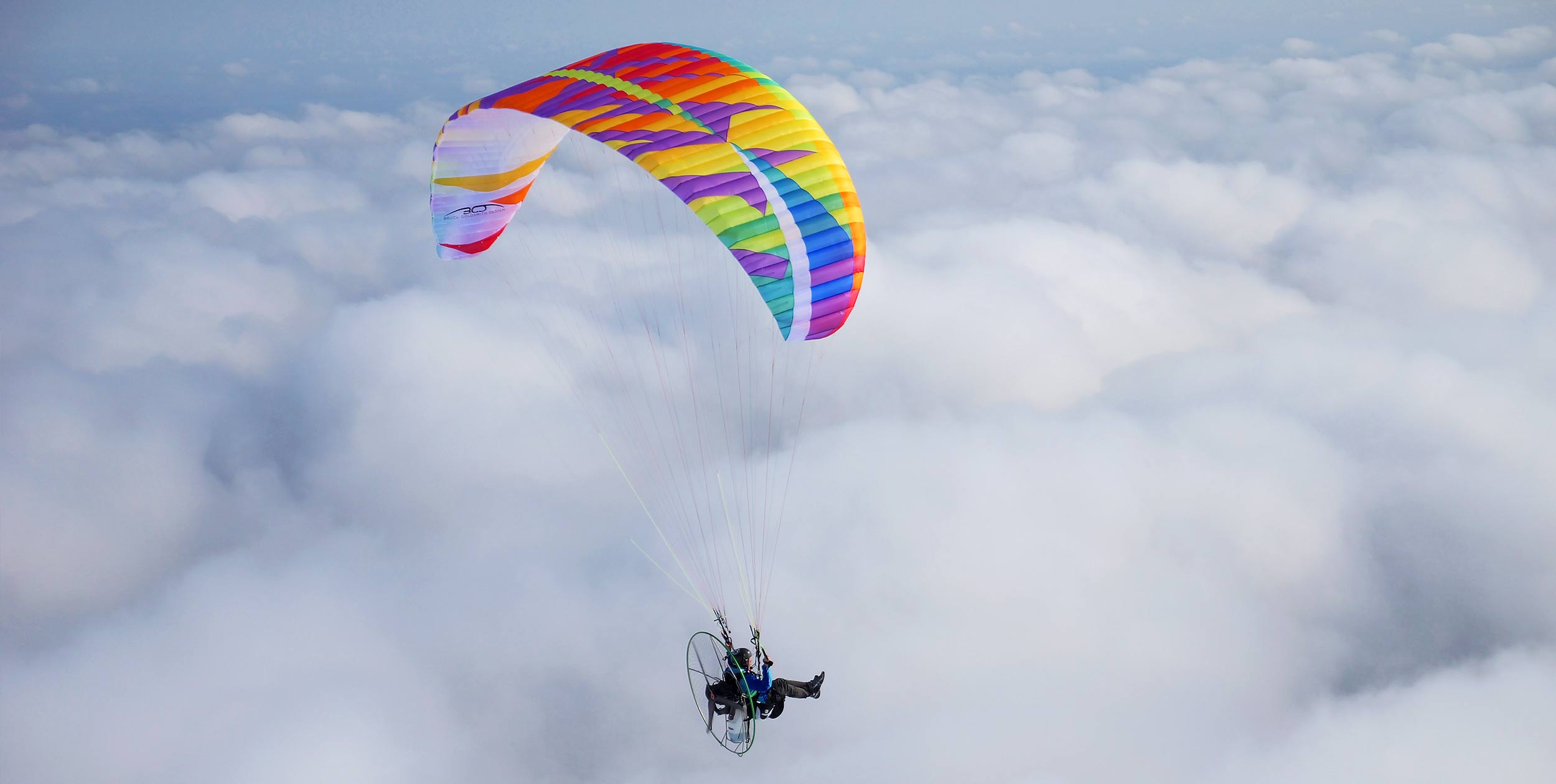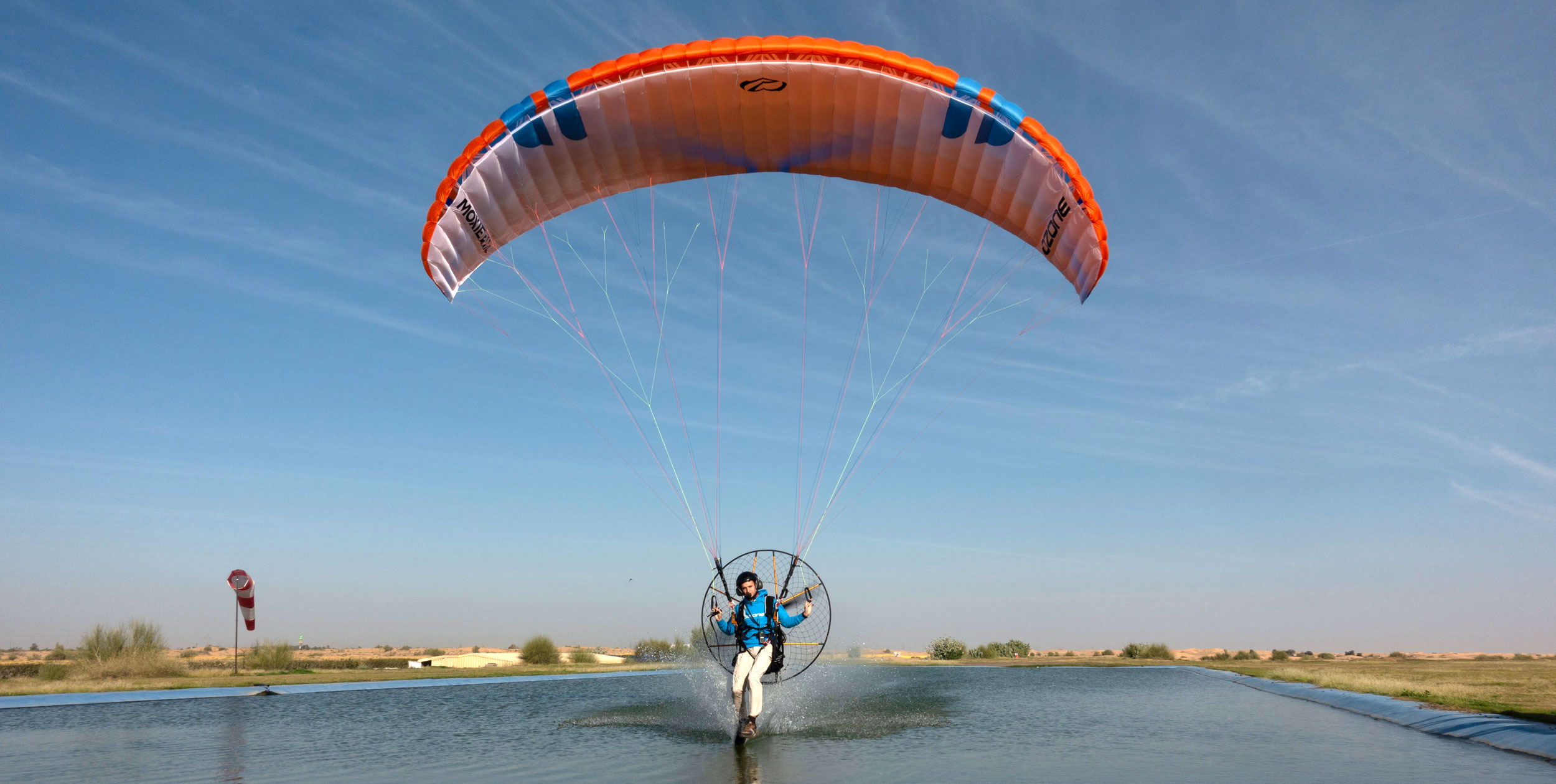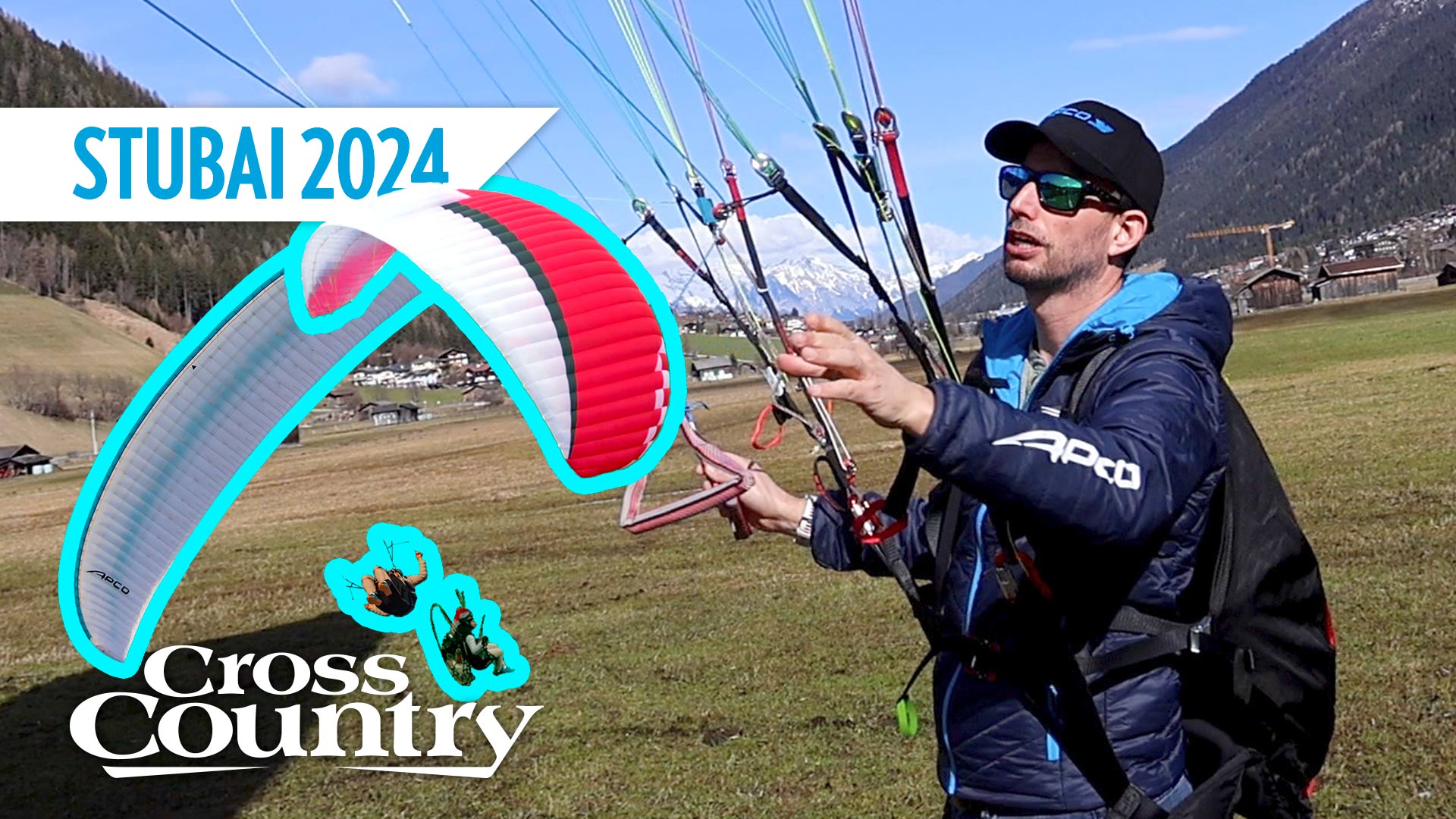The F3 is billed as an ultimate all-round paramotor wing for weekend pilots. Peter Blokker checks it out
Photos: Frank Mulder / Apco
The F3 is presented by Apco as the ultimate all-round wing for weekend warriors. It sits between their easy-to-fly Lift range and the fast F1.
Apco created the F3 for pilots who are looking for F1 performance combined with high stability and safety. During the development the wing was nicknamed “baby F1” because it shares many of its bigger brother’s design characteristics. If you’re done with your school wing, the F3 will take your paramotor career to the next level. Or at least that’s the promise.
I was eager to explore the potential of this wing, but a persistent strong northeasterly wind kept me grounded for over five weeks in spring. But a window finally appeared promising reasonable flying weather – it was enough.
There is an unwritten rule that helps keep me alive in my paragliding, Base jumping and paramotoring. Never change more than one item of your equipment at a time, and try that new stuff while current under perfect conditions at a spot that you know.
After being grounded for weeks and the fresh F3 screaming to get into the air, I had to break this rule. I had spent some of the unflyable weeks making changes to my motor and searching for new airfields. So there I was, under a cloudy sky with new gear after a long winter, finally unpacking the F3. If it behaved as Apco promised, there’d be nothing to worry about and we would become friends pretty fast.
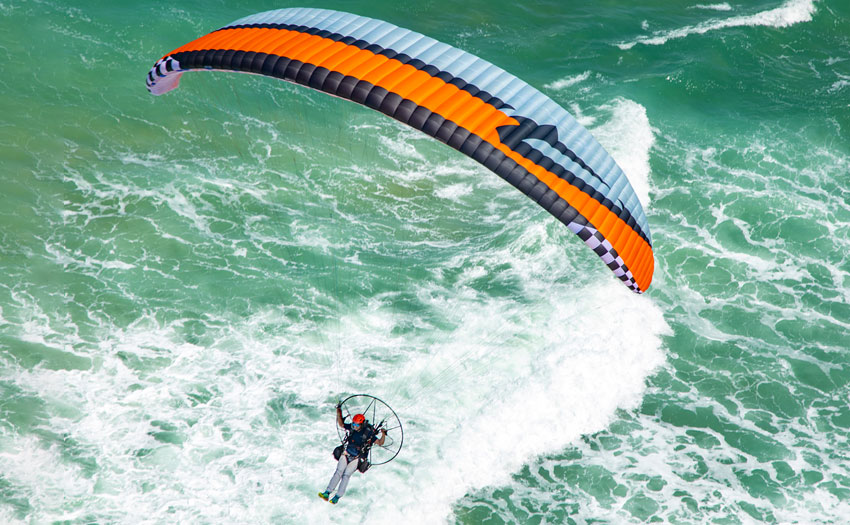
The wing inspires confidence with high internal pressure
Build and construction
The F3 is light for a paramotor wing. Although light weight doesn’t seem interesting for paramotoring, it has more advantages than only fewer kilos and a small packing volume. Light wings come up easily in nil-wind and less inertia makes the wing more pitch stable. On the F3 the 27g/m² bottom skin saves additional weight while the top surface of double-coated 42g/m² ripstop nylon makes it durable and guarantees porosity resistance.
There is a long list of technologies in the F3, consistently labelled with three letter abbreviations and technical graphics. Some of them really stand out, are unique to Apco and I noticed them straight away when laying out.

Although the sewing of the HIT valves doesn’t look that clean, they do a good job of keeping the wing pressurised when flown on a low angle of attack
Along the leading edge you can’t miss the mesh fabric, where the HIT valves are located. At high speed, when the angle of attack is low, the airflow hits the valves and helps to keep the wing pressurised.
In flight, the trained eye also notices the flow-aligned ribs. All ribs are aligned with the natural direction of the airflow, which allows a reduction in parasitic drag. Furthermore, commonly used techniques like 3D shaping of the leading edge and automatic cleaning ports at the wingtips are also present.
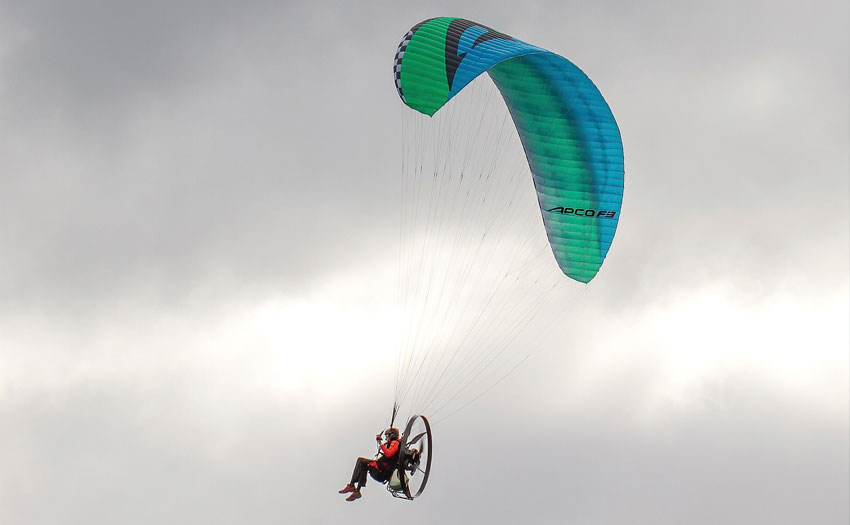
Despite bouncy conditions during the review it cut through the turbulence easily
Risers and lines
At first sight the riser set looks complicated. There is more metal then I have ever seen on risers but it is all there for a good reason and I appreciated it all in flight when exploring the full potential of the wing. The F3 is supplied with risers featuring a split A-riser: the inner is for setting up the wing and the outer is for pulling big ears. The riser is equipped with both an accelerator and trimmers. For the F3, Apco opted for a trimmer set-up that releases the B-riser, which results in a smooth and efficient profile.
More interesting is the One Action Acceleration system (OAA). As explained in the manual this uses the Brummel hooks on the bottom of the rear riser. When these Brummel hooks are unlocked, the full speed range can be accessed using the speedbar. In one smooth bar action you can reach the maximum speed of the wing without releasing the trimmers. It’s very clever, and it works very well. The change of airspeed at full bar is impressive.
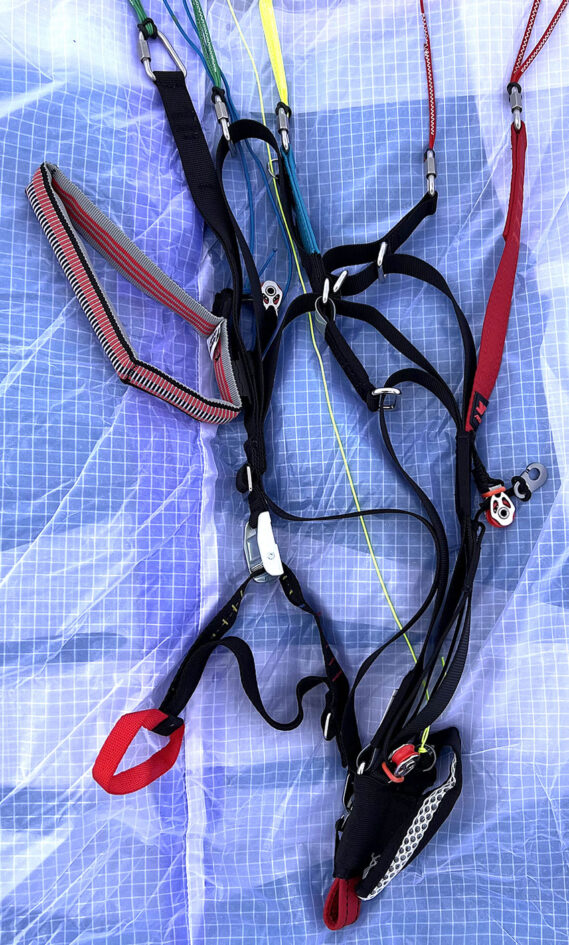
Complex at first glance, but the riser set offers many features to adjust airspeed along the wide speed range
If you’re not a fan of speed bars, the large trimmers provide a huge speed range and are easy to level out thanks to the coloured stitching, which gets wider further on the webbing. Red stitches are for slow trimming and take-off; blue stitches to fly neutral position or with OAA active; and many yellow stitches guide the wing to warp speed. If these marks ever wear out, no worries, the webbing of the trimmers is easily changeable.
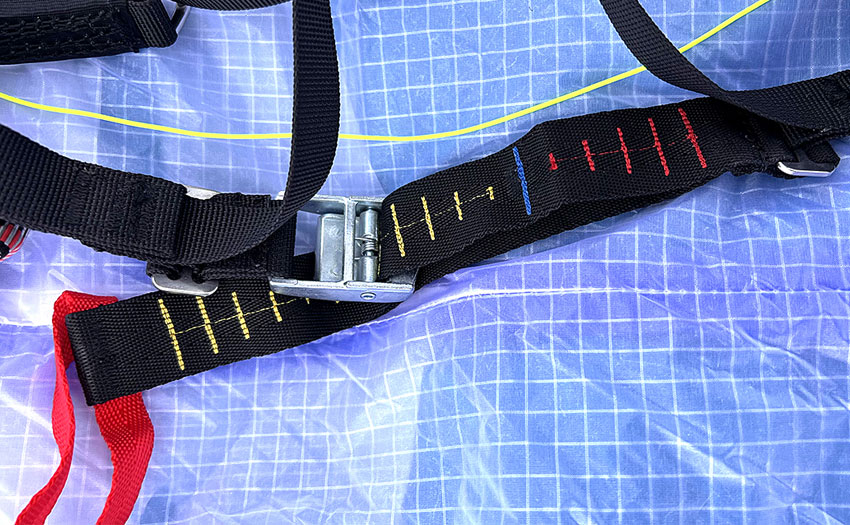
Trimmers are long but the markings make it easy to level out the left and right sides
The last thing to say about the risers is the comfortable tip-steering toggle. Although smaller than the brake toggle, these tip-steering toggles are the best I’ve seen on a paramotor wing. They are nice to grab with more than two fingers and much easier to grasp then those small loops on most other gliders, hiding somewhere behind the B-risers. Fly full speed for a long time, and this is a feature that you will like. For high hangpoints and trikes, there is a 14KIT with longer tip-steering lines and an additional magnet and guide ring, which is fitted to the risers.
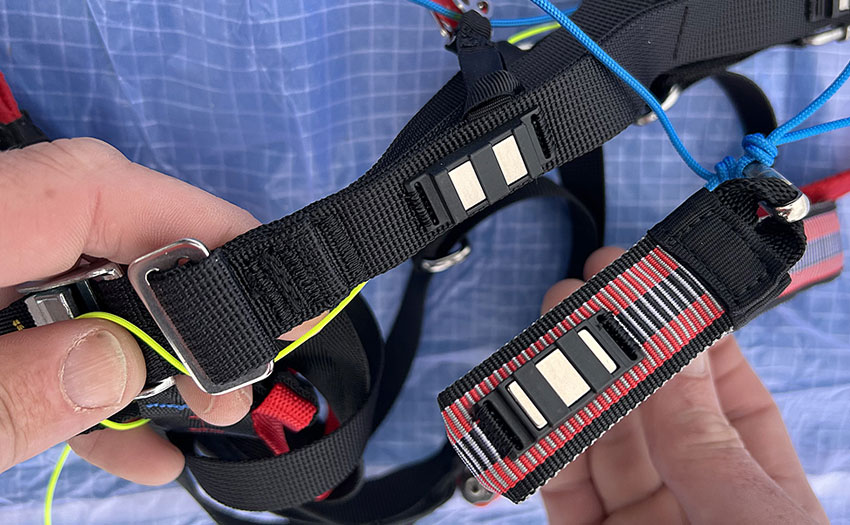
Comfortable brake toggles with strong magnets
The risers are connected to the sheathed Kevlar lines with stainless steel karabiners. I like the choice of Kevlar lines, because the wing will stay nicely trimmed for a longer time. The shorter top lines are made of Dyneema and connected to the wing without Apco’s embedded hook-in points instead of standard loops. This looks clean and solid and is life-time warranted.
Taking off
The take-off characteristics of a paramotor wing are very important. Most pilots are exhausted after three failed launches and no pilot wants to run longer than necessary before getting airborne. The F3 understands that very well.
The Flexon baton system that Apco invented and uses to keep the leading edge in shape improves the launch. The leading edge looks hungry to get in the air with their nicely aligned wide-open cells. It comes up gently with no tendency to overshoot and only needs a little bit of brake input, if any.
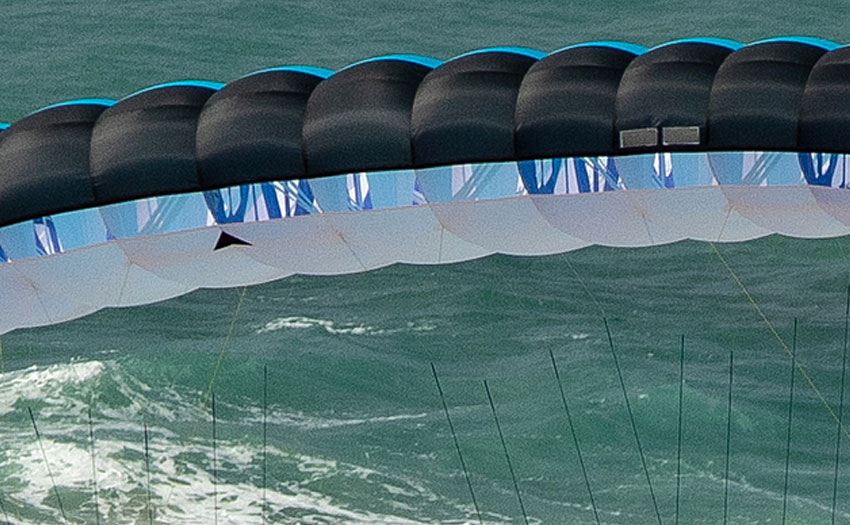
Close-up of the F3’s leading edge
On my first forward launch in almost nil wind I was very surprised by the immediate lift generated by the profile when the wing arrived above my head. I had to be gentle on the brakes and the throttle to prevent a turtle situation. I like to be pulled in the air and not on my back. It seemed that all I had to do is inflate the wing, hit the throttle and make a few steps with a little bit of brake applied.
My next launches in stronger wind were even easier. In a reverse launch the wing came up overhead quite fast, but the design and reflex profile prevented the wing overshooting. Again, I had to be gentle on the brakes not to get lifted before turned.
With trimmers fully closed on take-off I only needed three steps to get in the air after a reverse launch. It takes only a few minutes of groundhandling to get used to the behaviour of this wing and you’re ready for many successful launches. If you fail a launch on this wing, it’s your fault.
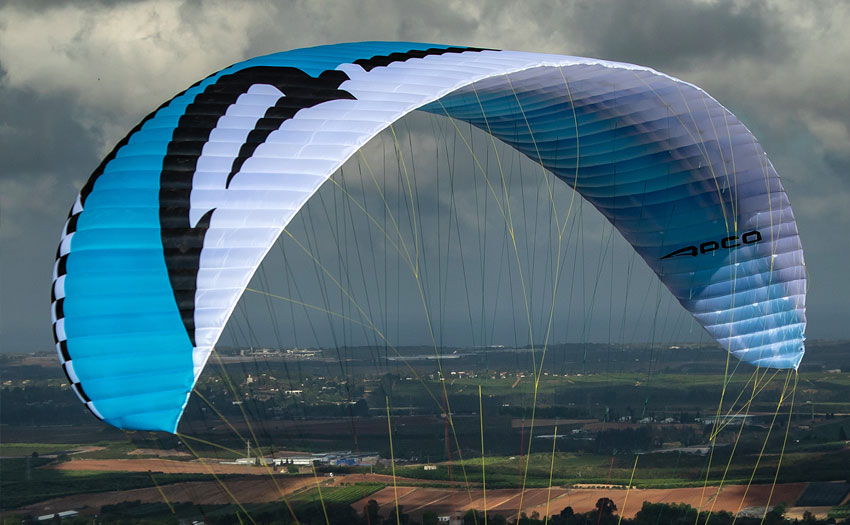
Apco F3’s sail
In the air
The F3 is marketed as an all-round wing. Normally I’m a bit sceptical about all-round wings. It’s not easy to design a wing that’s safe, easy to fly, stable, fast and playful. The F3 is one of the few wings I’ve flown that truly deserves the title of an all-round wing.
Slow trimmed, the F3 is a nice toy to make steep turns and keeps you confident with high internal pressure. With the trimmers opened completely I got about 15km/h more airspeed than in neutral (37 to 52 km/h). Pushing the speedbar added another 10km/h (GPS speeds). The faster I flew, the more stable the wing felt, thanks to the full reflex profile. That’s a nice way to cover distance! So yes, it’s good for cross country flying as well.
I was curious about the One Action Acceleration system and opened the Brummel hooks to unlock the system after placing the trimmers in neutral. Using only the speedbar I pushed the wing from 37 to 60km/h. I like the use of trimmers over the speedbar, but with the F3 using the speedbar with OAA activated makes sense.
During my first flights on the F3 the weather was a bit unstable and bumpy. Despite the bouncy conditions, the full reflex wing cuts the turbulent air as a hot knife through butter with no pitching movements. On full speed the tip-steering controls are comfortable and effective.
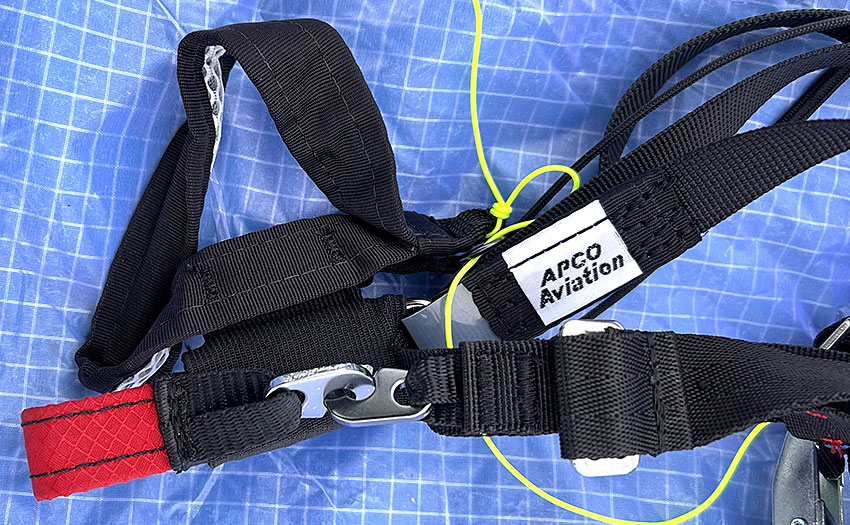
In open position the OAA system makes it possible to cover the entire speed range with the speed bar
Landing
The huge speed range of this wing is very useful when it comes to landing. With the trimmers adjusted somewhere between neutral and zero (the latter for nil wind), the groundspeed is manageable. The brakes have a nice long travel. Converting speed into lift during flare is easy.
Personally I preferred to bring the glider down with the back risers instead of the brakes, after turning towards the wing. Using the brakes in stronger wind conditions generates pull force and lift. In general the landing and flaring characteristics of the F3 are just perfect and there is not much more to say about that.
Manoeuvres
The wing felt so stable that even with not a lot of airtime on this wing I was confident enough to try the basic SIV manoeuvres. As I expected, it was not that exciting. The F3 recovers very fast from asymmetric and front collapses. The split A-risers make pulling big ears easy and gave me a descent rate of 6m/s. Spiralling down went faster and it’s quite easy to enter a spiral on this playful wing.
According to the manual it should be possible to do a B-stall on the wing but for me it didn’t work: I pulled myself from my seatboard before the B-stall stabilised. But who cares? There are better ways to lose altitude.
The verdict
Apco promised an all-round wing and the F3 really deserves this title. It’s a very stable wing that will look after you in long flights. The wing is playful and fast enough to cover distance on cross-country flights. Calling it a baby F1 doesn’t do justice to this wing, it’s a fully grown wing with high-level performance.
Apco say it’s not a beginner wing and that’s true, because it’s quite fast in turns and has a higher landing speed. But moving up from your school or beginner wing, the F3 will be a good choice if you want to play and fly longer distances with the same wing while expanding your skills and boundaries.
Manufacturer’s SPECIFICATIONS
Apco say: “F3 is Apco’s Sport Class cross country paramotor wing. Intended for weekend warriors with a focus on pure, enjoyable, reliable and confidence-inspiring performance.”
Use: Foot-launched solo paramotor or light trike. Big brother F3bi is certified up to a whopping 430kg and can handle big tandem trikes.
Pilot level: Intermediate pilots and above
Sizes (flat area m²): 22, 24, 26, 36 (bi)
Certified take-off weight (kg): 70-100 (120 trike), 70-120 (140 trike), 70-140 (165 trike), bi 430
Glider weight (kg): 4.35, 4.6, 5.05, 8.30
Cells: 56, 58, 60, 58 (bi)
Flat aspect ratio: 5.77, 6.0, 6.23, 6.0 (bi)
Certification: DGAC, Load tested according to EN-926-1
Published in issue 243 (September 2023)
Peter Blocker has been flying for 20 years and is a paragliding and paramotor instructor and mountain leader. Peter flew the F3 size 24 (70-120kg) using a Scout One with Vittorazi Moster 185 Plus engine at an all-up weight of 110kg


